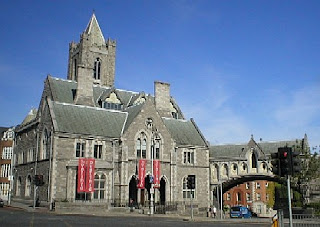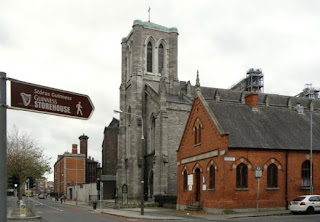Standing on high ground in the oldest part of Dublin, Christ Church Cathedral is one of the city's finest historic buildings. Part of the Anglican Church of Ireland, the cathedral is the mother church for the diocese of Dublin and Glendalough. It is one of two Protestant cathedrals in Dublin; the other being St. Patrick's Cathedral, just to the south
History of Christ Church Cathedral
The first Christianized Danish king, Sitric (Sigtryggr Silkbeard), built a wooden church at this site in 1038. On the brow of a hill inside the city walls, it was the most commanding position in Dublin. The present stone cathedral was begun in 1172 after the conquest of Dublin byStrongbow (a.k.a. Richard de Clare), a Norman baron. Construction continued well into the 13th century, so a transition from Norman to Early English Gothic styles can be seen in the architecture.
The cathedral's vault collapsed in 1562, bringing down the south side of the nave with it. It was rebuilt in the 17th century.
Funded by the distiller Henry Roe, the cathedral was heavily restored by architect G. E. Street in 1871-78. As with many Victorian renovations, the work was important for preserving the ancient building but also robbed the cathedral of much of its medieval character. The exterior was entirely refaced and the interior was fully renovated in a Victorian Neo-Gothic style. Street also rebuilt the tower and added external buttresses.
What to See at Christ Church Cathedral
The exterior was almost entirely refaced with new stone during the restoration of 1875 but retains the original Norman and Early English structure. South of the transept are the ruins of the 13th-century chapter house. The transept itself has a fine Romanesque portal, which was moved here from the north side in 1826.
The nave was begun in 1234 in the Early English style, with pointed arches. The south wall of the nave was rebuilt in the 17th century after the vault collapsed, but the north wall is original. Also original from the 13th century are the west bay of the choir and carved capitals in the nave, transept and choir.
The south aisle of the nave contains the tomb of Strongbow (d. 1196), with an impressive effigy of an armored knight. The small figure may have a visceral monument, intended to hold the organs of the nobleman. Also in the south aisle is the state pew, reserved for national government officials. The north aisle contains the civic pew, used by the Lord Mayor and city officials, and the baptistery donated by Sir Thomas Drew (d. 1910).
The Victorian choir screen was made by G. E. Street in 1875, but the fine brass lectern is from the late medieval period. The transept and choir are the earliest parts of the cathedral other than the crypt, dating from the late 12th and early 13th centuries. The north transept has a monument to Sir Henry Sydney; the south has the tomb of 19th Earl of Kildare (d . 1734) by Sir Henry Cheere.
On the east side of the south transept is the Chapel of St. Laurence O'Toole (d. 1180), which centers on a heart-shaped iron reliquary containing the saint's embalmed heart. Remarkably, the relic survived the Reformation and still stands in its original location. Other medieval survivals in this chapel include the 13th-century floor tiles, which were used as a model for the 19th-century tiles elsewhere, and the effigies of a prior (1212) and a lady who is said to be the wife or sister of Strongbow.
The chancel was built on the traditional medieval plan, with an ambulatory around a semicircular choir, but it was extended in the east in 1358 to accommodate a rectangular Lady Chapel and two side chapels. The north chapel is dedicated to St. Edmund and the south to St. Laud.
Dating from the 12th and 13th centuries, the atmospheric crypt is Dublin's oldest surviving structure. It contains the Treasures of Christ Church exhibition, which displays manuscripts, the tabernacle and candlesticks used when James II worshipped here in 1689, and other artifacts. The crypt can be accessed via stairs from the south aisle or from a door outside the south transept.
A charming covered bridge, added by Street in 1875, connects the cathedral to the old Synod Hall, which now holds the Viking multi-media exhibition "Dublinia."


















































